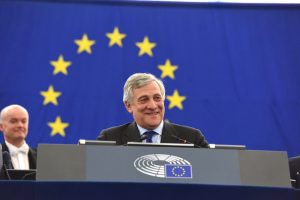The composition of the European Parliament
The European Parliament has five elements:
- The Members of the European Parliament
- The President of the European Parliament
- Parliamentary committees
- Rapporteurs
- The Secretariat
The Members of the European Parliament
The European Parliament has been expanding as the European Union membership has grown. The European Parliamentary Assembly met for the first time in Strasbourg in 1958 and consisted of 142 members. After the first enlargement of 1973, when the UK, Ireland and Denmark joined, the number of MEPs increased to 198. With the second enlargement, 24 Greek Members were added. With the third enlargement, the number grew to 518 and Spanish and Portuguese MEPs were added. After the German unification, the number of MEPs increased to 567. The fourth enlargement brought the number up to 626 (McCormick, 2011B, p. 205). After the Eastern Enlargement, the number increased to 788 but, according to the Nice Treaty, the total number of members had to be reduced proportionally and progressively to 736, and in order to ensure smooth technical operation of the Parliament the number of additional staff members was increased (Parliament all set for enlargement, 2004). However, due to subsequent enlargements, the current number of MEPs is 751.
The seats of the European Parliament are distributed on the basis of the Member States populations. However, the Treaty states that:
Article 14
The European Parliament shall be composed of representatives of the Union’s citizens. They shall not exceed seven hundred and fifty in number, plus the President. Representation of citizens shall be digressively proportional, with a minimum threshold of six members per Member State. No Member State shall be allocated more than ninety-six seats.
(Consolidated versions of the Treaty on European Union and the Treaty on the Functioning of the European Union, 2010)
Here is an interactive map that gives you information on MEPs from all Member States.
Find out how many MEPs are from:
- Germany
- Cyprus
- Malta
- Luxembourg
If the seats were divided strictly by population, the numbers of MEPs from each country would be :
- Germany 124
- Cyprus 1
- Malta 0
- Luxembourg 0
As you can see. under the rules introduced by the Treaty of Lisbon, large Member States have fewer MEPs per capita than the small states.
After being elected, the members of the European Parliament do not sit in the national groups, but in political groups. There are 8 political groups in the Parliament. The European People’s Party (Christian Democrats) has the most seats since the last elections.
See the results of the 2014 elections
- What are the other groups in the European Parliament?
- Are they all pro-European?
The President of the European Parliament
The President of the European Parliament is elected for a renewable term of two and a half years. S/he is assisted by 14 Vice-Presidents. The Rules of Procedure set out the main function of the President :
- representing the European Parliament in its relations with other EU institutions or outside the EU.
- chairing the plenary sessions.
- overseeing the work of the Parliament and ensuring that it adheres to the Rules of Procedure.
- signing the EU’s budget and all legislative acts after adoption by the Parliament.
The Parliamentary Committees and Rapporteurs
The legislative function of the European Parliament is aided by a network of committees. There are around 20 permanent Committees and together they create an effective mechanism for finding agreements across all political groups. Their sizes vary between 20 and 80 members. The membership of a committee is sought after, as this is where the law is shaped. Nevertheless, the appointment depends on the seniority of an MEP and the size of the political group to which s/he belongs. The Conciliation Committee meets when the European Parliament and the Council cannot decide on the wording of the legislation. In response to pressing political issues, special Committees are set-up (McCormick, 2011 B, p. 213).
The policy-specialised Committees examine proposals and amend them, if needed, before the plenary meeting, where the Parliament will sit to vote on the legislation. A rapporteur is also appointed: s/he is an MEP who drafts a report on the proposal which is put to the European Parliament before the plenary session.
All the meetings of the European Parliament are held in public and are attended by those who want to influence the legislation – lobbyists, officials from the Council, members of national governments (Shackleton, 2012, p.134).
Watch this video from the European People’s Party to gain a better understanding of the working of the Committees:
The Secretariat
The Secretariat is the internal administration of the European Parliament. As you remember, it sits in Luxembourg. From there, it organises plenary meetings, co-ordinates the legislative work, and offers technical and expert assistance to the Parliament. It employs:
- around 2,000 translators and interpreters
- around 1,000 assistants to European Parliament groups
- around 3,000 civil servants who are recruited from all EU member states
You do not need to remember the numbers, but note the importance of the translators and interpreters in the working of the European Parliament.
Calendar
| M | T | W | T | F | S | S |
|---|---|---|---|---|---|---|
| 1 | 2 | 3 | 4 | 5 | ||
| 6 | 7 | 8 | 9 | 10 | 11 | 12 |
| 13 | 14 | 15 | 16 | 17 | 18 | 19 |
| 20 | 21 | 22 | 23 | 24 | 25 | 26 |
| 27 | 28 | 29 | 30 | 31 | ||

Leave a Reply